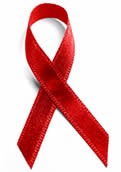Held on 1st December every year
 AIDS stands for Acquired Immune Deficiency Syndrome or Acquired Immunodeficiency Syndrome. It is a deadly condition, which results from the damage done by HIV (human immunodeficiency virus) to the immune system. The condition was first identified in 1981 and the name AIDS was first introduced on July 27, 1982. HIV can only be transmitted between people through direct contact of a mucous membrane or the blood stream with a bodily fluid. Hence, there has been a lot of stigma around the spread of HIV and people living with HIV and AIDS. It has been estimated that around 33 million people around the world have been infected with HIV and that around two million people die from AIDS related conditions each year. On October 27, 1988, the UN General Assembly officially recognized that the World Health Organization declared December 1, 1988, to be World AIDS Day. World AIDS Day has also been observed on this date each year since then.
AIDS stands for Acquired Immune Deficiency Syndrome or Acquired Immunodeficiency Syndrome. It is a deadly condition, which results from the damage done by HIV (human immunodeficiency virus) to the immune system. The condition was first identified in 1981 and the name AIDS was first introduced on July 27, 1982. HIV can only be transmitted between people through direct contact of a mucous membrane or the blood stream with a bodily fluid. Hence, there has been a lot of stigma around the spread of HIV and people living with HIV and AIDS. It has been estimated that around 33 million people around the world have been infected with HIV and that around two million people die from AIDS related conditions each year. On October 27, 1988, the UN General Assembly officially recognized that the World Health Organization declared December 1, 1988, to be World AIDS Day. World AIDS Day has also been observed on this date each year since then.
The United Nations' (UN) World AIDS Day is observed to honour those who have died of AIDS, for those who live with HIV or AIDS and to increase awareness of these conditions. It is held on December 1 each year. World AIDS Day is the focal point of the World AIDS Campaign, which is active all year round. During the days and weeks leading up to World AIDS Day, there is often a lot of coverage of the condition in the media and fund-raising for AIDS and HIV-related charities. In addition, health education campaigns aiming to reduce the transmission of HIV and discrimination of people living with HIV and AIDS are often launched on or around December 1. On World AIDS Day, many community, national and international leaders issue proclamations on supporting and treating people living with HIV and AIDS and stimulating research into the treatment of these conditions. The symbol of the World AIDS Campaign consists of a sketched image of a red ribbon and the words World Aids Campaign. The symbol was presented by the Visual AIDS Artists Caucus in 1991. Local communities may hold events to remember and honour members who have died of AIDS-related conditions or exhibitions around the subject. A particularly well-known example is the AIDS Memorial Quilt. This project allows friends or family members of a person who has died of AIDS to construct a quilt panel. The panels are then exhibited all over the United States.
Alternate Name - United Nations' (UN) World AIDS Day
Holiday Status - It is National Holiday
